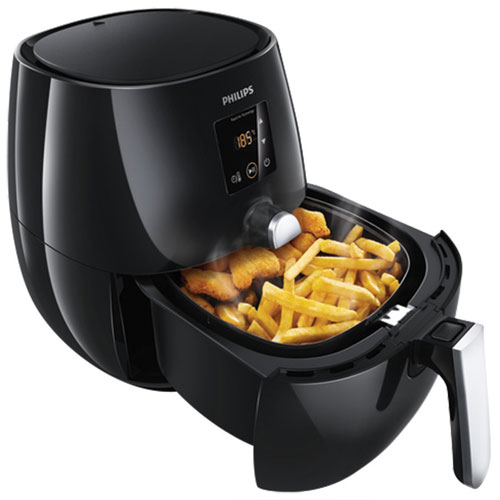
Today I examine the Philips Airfryer Viva Deep Fryer, which is a very unique appliance that I was particularly interested in testing when recently given the opportunity. If you’d like to achieve the same delicious effect of deep frying your food, but without all the oil (and generally producing an overall healthier meal), then this counter top cooker may well be for you! Read on for the full results of the extensive tests that my wife and I put this machine through, along with my ultimate recommendation of whether or not this particular appliance is worthy of a purchase!
First of all, I must admit that it took me a little while to figure out exactly what this machine was all about! In essence it’s a miniature convection oven—with the emphasis on miniature. It does, however, have a fairly large footprint for a counter top appliance, which I do find somewhat off-putting as there are definite space limitations in our kitchen.
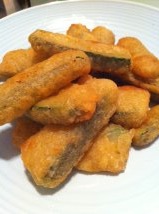 Appearance: Other aspects of the Philips Airfryer’s appearance include that it somewhat resembles a large black kettle with a drawer in the front that pulls out. This drawer is actually the cooking chamber, wherein you place the (included) mesh bottom basket that holds and cooks just about any dry food. There are also other accessories available, such as a small cake pan, a shortish skewer set, and a special frying pan. These accessories are great for cooking specific types of foods, but they’re not actually included with the airfryer and must be purchased separately. As mentioned above, the airfryer’s footprint is also fairly significant for a counter top appliance. It is approximately the same size as our 4 slice, wide slot toaster, and it’s at least twice as high as well. I was really quite surprised by its size when I first saw it, having previously only seen online photos at Best Buy. It’s not a bad looking machine—shiny black plastic with a contrasting silver dial in the front. But it does require a good bit of space to call its home.
Appearance: Other aspects of the Philips Airfryer’s appearance include that it somewhat resembles a large black kettle with a drawer in the front that pulls out. This drawer is actually the cooking chamber, wherein you place the (included) mesh bottom basket that holds and cooks just about any dry food. There are also other accessories available, such as a small cake pan, a shortish skewer set, and a special frying pan. These accessories are great for cooking specific types of foods, but they’re not actually included with the airfryer and must be purchased separately. As mentioned above, the airfryer’s footprint is also fairly significant for a counter top appliance. It is approximately the same size as our 4 slice, wide slot toaster, and it’s at least twice as high as well. I was really quite surprised by its size when I first saw it, having previously only seen online photos at Best Buy. It’s not a bad looking machine—shiny black plastic with a contrasting silver dial in the front. But it does require a good bit of space to call its home.
Features & Specs: The Philips Airfryer is as versatile a cooker as many full sized ovens (and then some!), but its total food capacity is only listed as being 0.8 Kg, which is really quite limiting. Even so, it boasts a number of cooking method options, including the ability to fry, grill, roast, & bake, and its “Rapid Air Technology” makes “deep” frying a healthier choice than ever before as the rapid airflow system achieves the same result as oil would do in an actual deep fryer. It also features an anti-odour filter to reduce food smells in your kitchen, and its basket and bowl are both dishwasher safe. A two-year parts warranty rounds out the airfryer’s key specs and features, proving a sense of some added piece of mind.
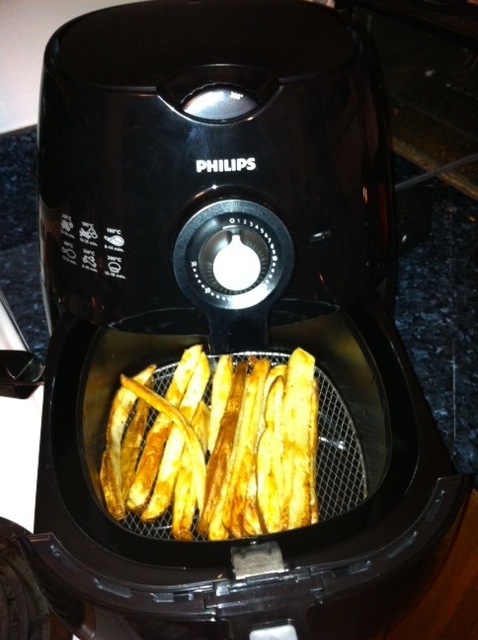 Testing: I love french fries! It makes sense, then, that my first test with the Philips Air Fryer was making fresh, homemade, hand cut french fries. My wife and I used a recipe from the fryer’s companion cookbook (a pretty good, if relatively short, recipe book with some fairly interesting & unexpected ideas in it, including a tasty sounding recipe for crab cakes, for instance. We never actually tried that one out though.). Anyway, the book said to use starchy “baking” potatoes (i.e., russets), which were first to be soaked in cold water for at least 30 minutes, then to be patted fully dry, and then to be placed in the fryer for cooking. We cut decent sized pieces as I like my fries a bit on the larger size. To test the fryer’s capacity, we filled the basket to the max line and then followed the cooking instructions. As the fries neared the end of their prescribed cooking time, we realized that there were far too many potatoes in the basket for them to cook properly. After removing about 1/3 of the chips, we continued to cook the remainder for another 10-15 minutes before they were finally ready. The results were very good—a fairly crispy outside and fluffy potato inside. We actually turned it into a poutine before digging in, and I would have to say that it was one of the absolute best poutines I have ever inhaled! I never would have expected to accomplish this at home!
Testing: I love french fries! It makes sense, then, that my first test with the Philips Air Fryer was making fresh, homemade, hand cut french fries. My wife and I used a recipe from the fryer’s companion cookbook (a pretty good, if relatively short, recipe book with some fairly interesting & unexpected ideas in it, including a tasty sounding recipe for crab cakes, for instance. We never actually tried that one out though.). Anyway, the book said to use starchy “baking” potatoes (i.e., russets), which were first to be soaked in cold water for at least 30 minutes, then to be patted fully dry, and then to be placed in the fryer for cooking. We cut decent sized pieces as I like my fries a bit on the larger size. To test the fryer’s capacity, we filled the basket to the max line and then followed the cooking instructions. As the fries neared the end of their prescribed cooking time, we realized that there were far too many potatoes in the basket for them to cook properly. After removing about 1/3 of the chips, we continued to cook the remainder for another 10-15 minutes before they were finally ready. The results were very good—a fairly crispy outside and fluffy potato inside. We actually turned it into a poutine before digging in, and I would have to say that it was one of the absolute best poutines I have ever inhaled! I never would have expected to accomplish this at home!
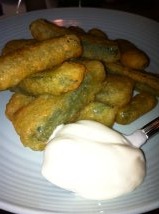 We also tested a few ready to bake products such as spring rolls, popcorn chicken, and zucchini sticks. As these ready made products already contain oil from their initial preparation, additional oil was not required to “fry” them up. The Airfryer actually worked extremely well with these products: They were crispy on the outside and piping hot inside! The cooking time was approximately the same as was suggested in the instructions for using a standard oven. However, no turning of the product was necessary—all we had to do was give the basket a shake once or twice during cooking. Another plus with the Philips Airfryer is that, due to its small size as compared with a typical floor mounted, full-sized oven, it fully preheats in about 1 minute, cutting waiting time down to practically nothing.
We also tested a few ready to bake products such as spring rolls, popcorn chicken, and zucchini sticks. As these ready made products already contain oil from their initial preparation, additional oil was not required to “fry” them up. The Airfryer actually worked extremely well with these products: They were crispy on the outside and piping hot inside! The cooking time was approximately the same as was suggested in the instructions for using a standard oven. However, no turning of the product was necessary—all we had to do was give the basket a shake once or twice during cooking. Another plus with the Philips Airfryer is that, due to its small size as compared with a typical floor mounted, full-sized oven, it fully preheats in about 1 minute, cutting waiting time down to practically nothing.
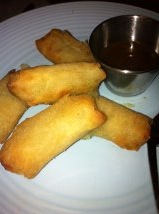 Cleanup: Cleanup of the Philips Airfryer is a bit more work than I’d like for it to be. This is mostly due to the fryer basket’s mesh bottom, which easily accumulates tiny pieces of burned on food during cooking. The bits kind of get cooked into the mesh, and it’s a real pain to get everything off again. However, you don’t necessarily have to use the mesh basket for many cooking tasks, and, in general, everything else about the airfryer is pretty much a no-stick affair, and it typically cleans up with relatively little effort.
Cleanup: Cleanup of the Philips Airfryer is a bit more work than I’d like for it to be. This is mostly due to the fryer basket’s mesh bottom, which easily accumulates tiny pieces of burned on food during cooking. The bits kind of get cooked into the mesh, and it’s a real pain to get everything off again. However, you don’t necessarily have to use the mesh basket for many cooking tasks, and, in general, everything else about the airfryer is pretty much a no-stick affair, and it typically cleans up with relatively little effort.
Evaluation: Overall I liked the airfryer quite a bit, but there were definitely some drawbacks. For one thing, it produces a considerable amount of noise when running. We have an open concept living room and kitchen, and both of us really found the noise to be quite bothersome. My wife likened it to a small jet engine, and, while she does sometimes have a flair for the dramatic, I honestly couldn’t disagree with her. At one point I tried to check some hockey scores on TV and I couldn’t really hear much of what was being said. This is despite the fact that there’s a good bit of distance between the kitchen counter where the airfryer was located and where I myself was sitting (reasonably close to the TV). The airfryer did do a really great job on everything we cooked in it though, and I was thoroughly impressed in this regard. Unfortunately, the cooking chamber is far too small to cook a decent quantity of food, and if you overfill the chamber, it slows down the entire process significantly. For my wife and I to both have a bowl of poutine, for example, we actually had to cook two batches of fries and eat them at different times from each other. That’s ridiculous!
To my way of thinking, the cooking chamber is simply much too small to make full, family sized meals in, and while I really love the airfryer’s cooking results, it’s probably best employed as a machine for cooking snacks & side dishes for a maximum of two people—definitely not for parties!
Final Thoughts: The bottom line here is that the Philips Airfryer is not going to be for everyone! If you don’t mind how much room it takes up on your counter top and the fact that it’s both noisy and has limited cooking capacity, then by all means, go ahead and pick one up! You’re bound to be happy with the actual cooking results. As I have said repeatedly throughout this blog, the cooking outcome itself is very very good with the fryer and the food is extremely tasty—you’re just not going to be eating great quantities of it all at one time. So if these negative points are not the kinds of things that tend to put you off, you’ll probably be very happy with this product, because the overall cooking quality is definitely there. It also has highly positive feedback from a number of Best Buy customers, which I’m sure counts for a great deal! I’d love to hear your opinion on this product. Do the positives outweigh the negatives for you? Is the Philips Airfryer on your shopping list? Whatever you decide, best wishes to you!



